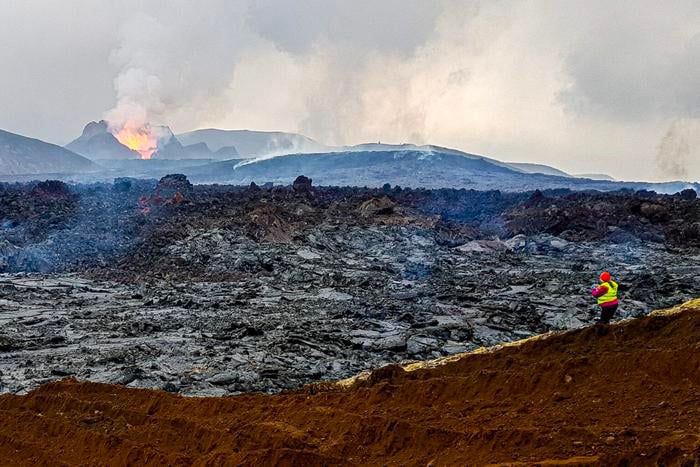For the first time, scientists have proven that simple earthen barriers can effectively divert and delay destructive lava flows from active volcanoes, potentially saving homes and critical infrastructure from destruction.
A field experiment conducted during Iceland’s 2021 Fagradalsfjall eruption has transformed how communities defend against volcanic hazards, with these techniques already protecting the town of Grindavík during subsequent eruptions. This innovation, spearheaded by Professor Fjóla Guðrún Sigtryggsdóttir and her team, marks a significant advancement in volcanic hazard mitigation that could benefit vulnerable communities worldwide.
Fighting Fire with Earth: The Surprising Success of Simple Materials
When Fagradalsfjall volcano roared to life in March 2021 after 800 years of dormancy, it presented a unique opportunity. While tourists flocked to witness nature’s fireworks, engineers and scientists saw something else: a chance to test whether earthen barriers could effectively control lava flows.
“We moved a cube and a sphere around the lab and used the high-speed camera to record the laser flashes reflected from different points on these objects at different times,” explained Victoria Helm and Dominik Hornof, the students who conducted the experiment. “If you get the timing right, you can create a situation that produces the same results as if the speed of light were no more than 2 metres per second.”
Using bulldozers and excavators, the team constructed three dams and two diversion barriers from locally available materials like soil and volcanic gravel. Their effort paid off dramatically — the largest dam delayed lava advancement by up to 16 days, while diversion barriers successfully redirected flows away from vulnerable areas.
How Lava Type Determines Barrier Design
The research revealed crucial differences in how various lava types interact with barriers. Two primary types required different approaches:
- ʻAʻā lava (chunky, blocky lava) — Thickens considerably behind barriers, with fresh lava flowing beneath a chilled outer crust, creating substantial pressure
- Pāhoehoe lava (smooth, flowing lava) — Accumulates in sheets, eventually overtopping or bypassing barriers, but causes less damage when moving slowly
- Hybrid types — Required flexible barrier designs that could adapt to changing flow characteristics
- Emergency heaps — Quick earthen piles provided valuable temporary protection during construction of larger barriers
“This makes it look to us as if the cube had been rotated,” said Peter Schattschneider from TU Wien, describing how the barriers affect lava flow patterns. The research demonstrated that steeper slopes and strategic barrier placement significantly improved effectiveness, though rapidly flowing pāhoehoe lava could still cause downstream erosion in barriers with weak, loosely constructed tops.
From Experiment to Real-World Protection
Could these findings really protect towns and infrastructure from volcanic destruction? Iceland put this question to the test just two years later when volcanic unrest threatened the fishing town of Grindavík and a nearby geothermal power plant vital to the region’s energy security.
In November 2023, following earthquake swarms indicating an imminent eruption, Icelandic authorities rapidly implemented the barrier construction techniques developed during the Fagradalsfjall experiment. Working around the clock, construction crews built massive earthen barriers reaching up to 10 meters high and 40 meters wide at their base.
When eruptions began in December 2023 and subsequently in January 2024, these barriers proved remarkably effective. Despite a fissure opening that crossed through one section of the barrier, the town suffered minimal damage compared to what could have been complete destruction.
Racing Against Molten Rock
Building defenses near active volcanoes presents extraordinary challenges. Construction teams must often work in hazardous conditions with toxic gases, extreme heat, and the constant threat of sudden eruptions. The experience gained during the 2021 experiment prepared teams for these demanding conditions.
What makes this approach particularly valuable is its accessibility. Unlike high-tech solutions, earthen barriers can be constructed quickly using locally available materials and standard construction equipment — a critical advantage when time is limited and resources are constrained.
Does this mean communities near volcanoes can now feel completely secure? While the barriers have proven effective, researchers caution that no defense is absolute. The barriers work best as part of a comprehensive hazard management strategy that includes early monitoring, evacuation plans, and ongoing research.
Looking Toward a Future of Increased Volcanic Activity
Iceland’s Reykjanes Peninsula entered a new period of volcanic activity in 2021 after centuries of dormancy. Scientists project this activity could continue for up to 300 years, threatening the 30,000 residents who call the peninsula home — approximately 8% of Iceland’s total population.
The volcanic systems on the peninsula had been quiet for nearly 800 years before awakening, creating a new reality that demands innovative protective measures. Since December 2023, the region has experienced multiple eruptions, with some continuing for months, creating a persistent threat to communities and infrastructure.
As volcanic activity continues to reshape Iceland’s landscape, the lessons learned from these earthen barriers provide a blueprint for communities worldwide facing similar hazards. From Hawaii to Italy, the techniques refined in Iceland could help protect lives, homes, and critical infrastructure from nature’s most powerful forces.
In a world increasingly shaped by climate instability and natural hazards, these simple yet effective barriers remind us that sometimes the most powerful solutions are also the most elemental — like using dirt to stop fire. As one researcher concluded: “Much is unpredictable, but civil society and infrastructure can be protected, and when we can, we must seize the opportunity and believe it will work.”
If our reporting has informed or inspired you, please consider making a donation. Every contribution, no matter the size, empowers us to continue delivering accurate, engaging, and trustworthy science and medical news. Independent journalism requires time, effort, and resources—your support ensures we can keep uncovering the stories that matter most to you.
Join us in making knowledge accessible and impactful. Thank you for standing with us!

